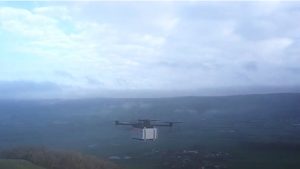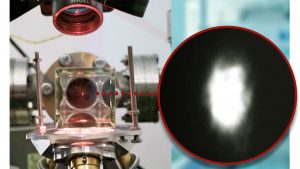Aquark Technologies is on a mission to simplify quantum technology, utilising and adapting cold-atom trapping to develop a more efficient and accessible system.
Determined to make quantum technology simpler, more manageable, and widely-accessible, Aquark Technologies is developing and testing new cold-atom trapping systems.
Andrei Dragomir, CEO and Co-founder, discusses the benefits of cold-atom trapping, how Aquark is utilising and adapting this technology, and the potential benefits and impact its system could have on the future of commercial technology.
What is cold-atom trapping?
Cold atoms (or cold matter) are created generally through a system called a magneto-optical trap. As the name suggests, this is a system that uses both magnetic fields and optical fields to confine a cloud of atoms in the centre of a vacuum chamber.
Effectively we are using lasers to force a cloud of atoms to stay still in an empty box. It is a strange thing as if one thinks of shining a laser on an object, the first guess is that the object will heat up.
However, as temperature is a function of how fast atoms are moving inside a body. By forcing the atoms to stay still, their temperature drops to almost absolute zero. This concept was invented several years ago, in 1985, and the inventors were awarded a noble prize due its importance.
The amazing thing is that once cooled, we can control and interrogate the atoms, which are extremely sensitive to different environmental parameters and can be used as a ruler. Not only are atoms the most precise ‘ruler’ in the world, but they are constant and the same everywhere in the Universe.
These capabilities result in amazing devices that can change the way we interact with the world. Cold-atom trapping technology will not only revolutionise existing markets, such as the field of position navigation and timing, but also unlock new opportunities and applications like next generation computing and scanning the underground for civil engineering applications and resources.
What importance does cold-atom trapping have to quantum technology as a whole?
The quantum technology space is currently divided into four main areas: Computing, communications, sensing, and imaging. There are several platforms that support the development of this ecosystem including superconductors, single photons, quantum dots, and diamond, to name a few.
Within this multitude of options, cold matter holds a special place as it is quite universal. Starting from the same core system, one can develop devices to cover almost all areas of applications of the quantum technology field: Gravity, rotation, acceleration, magnetic fields, electric fields, and many others.
Moving away from sensing applications, the same platform can be used for creating quantum memories, a key component of the computing and communication fields; or applied directly to creating qubits for computing purposes. Cold atoms make up a platform technology in a true sense of the word. Since we have been aware of these for quite some time, technology based on cold atoms is fairly well defined in laboratory environments, and is already defining our lives.
A good example is the atomic clock. These high precision instruments for measuring time sit at the core of the GPS system and almost everything in the world – financial transactions, internet, telecommunications, transport – has a time dependency offered by this system.
How is Aquark adopting this technology?
It seems that cold atoms have it all. Unfortunately, achieving cold atoms in the first place is an extremely complex task. Whilst these systems are well defined in the lab, that is also their biggest weakness.
They occupy entire rooms, require massive amounts of power, they are expensive, and require years of training to operate them. It has been a long task for the academic community to simplify this technology, and only now we are starting to see the results of these efforts and products based on cold matter starting to emerge on the market. Even in most commercial cases, sensors built on this platform are about the same size as a fridge or a washing machine.
At Aquark, we focus on improving the size, weight, power, and cost of cold matter systems in order to accelerate the development and adoption of products built on it. In addition to the format and cost of the technology, it is also exceptionally sensitive to its environment.
What makes it an exceptional platform for sensing applications is making these products viable for real world applications. Utilising 12 years of research and innovation, we addressed this challenge and shaped the technology to be suitable for commercial use. Specifically, we removed the magnetic field requirements of the system which consequently removed around half of the core system required for generating cold matter.
Together with innovation around the sub-components of the systems, such as developing new vacuum and laser stabilisation technology, we can now take this technology out of the lab.
What is Aquark’s vision, and how does this technology contribute to it?
Our big vision is to bring this technology to the world. ‘Quantum’ has such complex and scientific connotations, yet a lot of modern technology is derived from quantum science. The lasers we use every day to scan products in shops, and semiconductors on our computers and phones, are all based on quantum properties of different materials, but no one picks up their phone thinking about it as semiconductor technology.

Now, what we refer to as ‘quantum’ is actually a quantum second wave that is based on more complex effects like superposition and entanglement.
We aim to remove the daunting connotations of quantum from these products. Ultimately, the focus should remain on the benefits this technology can unlock. Working towards this goal and pushing the miniaturisation of this platform technology, we see ourselves as a company with a horizontal approach.
Starting with the creation of a robust and cost-effective cold-atom trapping system, we will continue to consider different applications, either by ourselves or through partnerships, until everyone benefits from what it offers.
Can you elaborate on the significance of the partnerships with Defence and Innovate UK in the development and field trials of this cold atom system?
We spun out of a very innovative and successful research group, starting this journey with a team of three. Deep tech is not only complicated, but also quite expensive. The support received by Innovate UK, combined with the support of our investors allowed us to achieve the first step in our vision quickly.
In one year after spinning out from University of Southampton, we already have built a cold-atom trapping system the size of a ‘shoe-box.’ A 19-inch, 5U, half depth network rack containing everything required to generate cold atoms at a push of button. Whilst all the devices of quantum technology based on cold atoms have a strong commercial application, there are a lot of potential applications that are extremely relevant to defence and national security.
For example, high precision atomic clocks can be used to check if a GPS signal has been tempered with. Gravimeters can potentially be used in border control to scan for bunkers underground. The combination of multiple quantum sensors can result in precise inertial navigation systems that would replace GPS in areas where the signal is unstable such as large cities.
Therefore, defence companies will be the first to adopt this type of deep tech. Since robustness is critical in this type of application, there was not a better partner to test our system in the field.
In what ways does the unique approach of Aquark Technologies in trapping and cooling atoms without using magnetic fields contribute to the practicality and accessibility of cold atom systems?
The concept of creating cold matter using a magneto optical trap has been around for about 30 years and scientists have recognised the potential importance of this technology. From the beginning, the academic world attempted to simplify this system with the view of exporting it out of the lab as soon as possible.
Now we have a lot of different system designs, and some of the work completed in the early 90s was focused on removing the need for a quadrupole magnetic field to generate cold matter. Some systems did emerge from this effort, however most increased in complexity.
The research group we spun out of was mainly focused on miniaturising the conventional magneto optical system. However, in our exploration, we came across this new system called a Supermolasses trap, which in a very simple and power efficient way, allows cold-atom trapping without the need of a quadrupole magnetic field.
This extremely resilient system allows us to effectively eliminate half of the system conventionally required for generating cold matter. It also proves to be extremely robust and resilient, allowing us to perform extremely fast prototyping exercises when it comes to its direct integration in different applications. As a company, we are already looking at cold matter based atomic clocks and gravimeters, with more to come.

Another key feature unlocked by this unique method for cold-atom trapping is what we call multiplexing. Since we do not have a magnetic field, we can generate multiple atom clouds in the same vacuum chamber. This can be used for either improving different products or for combining different sensors.
For example, if we combine an atomic clock with a rotational sensor and an accelerator, we create the basis for an inertial navigation system, all within a single vacuum chamber. This is another step forward towards making this technology simpler, cheaper, and more accessible.
What kind of data was gathered during the trials that can be considered invaluable for developing Aquark’s platform technology?
For us, the first step was to show that the core technology survives outside the lab environment. What makes these systems the best sensors in the world, also makes them very sensitive to their environment and engineering them into reliable products is not an easy thing.
We wanted to start our journey by taking a reference measurement of what our core system could survive at this stage. Throughout the two days of testing, we mainly monitored the stability of the atom cloud, its position and relative atom number. Alongside this, we also had a whole suite of conventional sensors to inform us on the environment and flight conditions.
We were surprised to discover that the system performed admirably during the flight. Moreover, the cloud itself is generally sensitive to environmental conditions, but the subcomponents of the system such as lasers and optics are really sensitive to thermal instabilities and mechanical shocks or vibrations.
In our trial, the system did not care that it was strapped to a drone performing quite aggressive manoeuvres, at 0ºC and over 80% humidity and the system maintained a cloud of cold atoms through the trial. These great results validated our effort and enable us now to move on to the next chapter in the company progress.
What is next for Aquark?
With the flight trial showing the robustness of our system, we are now moving towards the development of different devices based on this core engine. We started with the timing and gravity verticals, but we are keen to progress to all possible areas as soon as possible. At the same time, we are continuously pushing the improvement of size, weight, power, and cost of the core system until we reach a system that can be mass produced.
As we progress with reducing the complexity of the system, we will also move swiftly from application to application. However, taking on board this mission is a not an easy task. We are keen to collaborate with other companies with sensing expertise in the different verticals to which our system can apply.
Please note, this article will also appear in the seventeenth edition of our quarterly publication.









